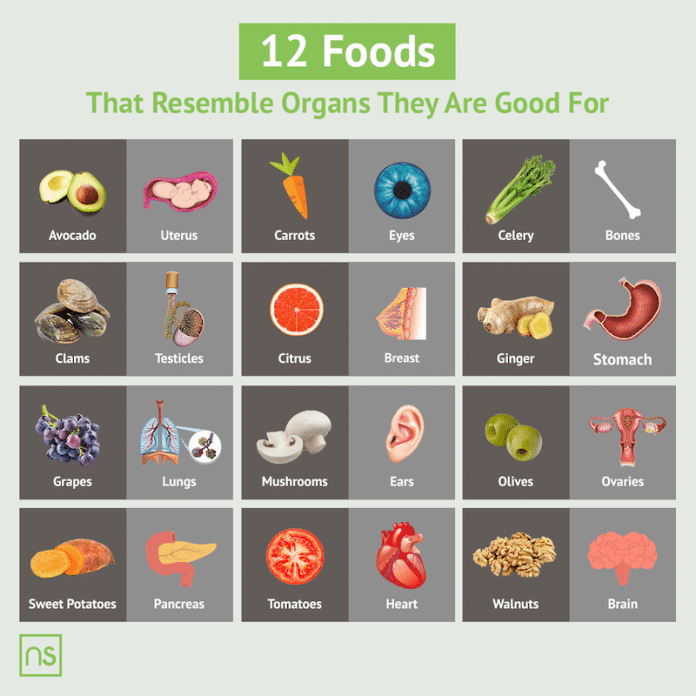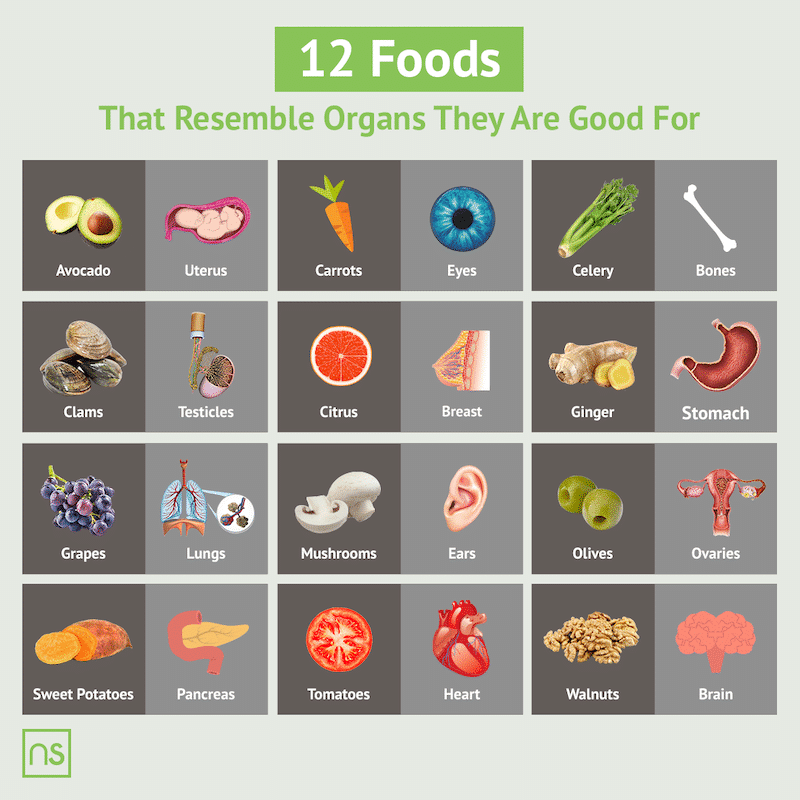
Centuries ago, many people followed a philosophy known as the Doctrine of Signatures. This way of thinking involved choosing certain fruits, vegetables, and other plants that resembled organs and deciding they must be good for that body part. Does that sound a bit bizarre?
It turns out our ancestors were not far off the mark. Here are 12 examples of foods that resemble organs they are good for and why.
1. Avocados and the uterus. An avocado contains omega-3 fatty acids, which helps lower the secretion of a hormone-like substance (prostaglandin) that can make the uterus contract and cause pain. Avocados are also an excellent source of vitamin C, which can help reduce the risk of fibroids developing in the uterus.
Read more about the delicious health benefits of avocados
2. Carrots and eyes. Perhaps the biggest contribution of carrots to eye health is its high level of beta-carotene, a potent antioxidant that the body converts to vitamin A. This vitamin plays a key role in reducing the chance of developing macular degeneration in older adults. Note, however, that carrots (or vitamin A) will not improve eyesight unless you have a vitamin A deficiency.
3. Celery and bones. Straight and sturdy, stalks of celery do resemble human bones, especially those in the legs and arms. Celery packs a good supply of vitamin K, which works at the cellular level, along with vitamin D, to build bone. Vitamin K also facilitates the absorption of calcium, a mineral critical for bone health. Other nutrients in celery that support bone health include vitamin C (helps form collagen, a protein that binds bone matrix cells together), magnesium (works with calcium), and manganese (helps make connective tissue in bone).
4. Clams and testicles. Foods that are rich in antioxidants help to prevent inflammation that can lead to a host of chronic illnesses including testicular cancer. Clams provide a wealth of antioxidants, including an extraordinary amount of selenium and excellent levels of copper, zinc, and vitamins A and C. Clams also have a fair amount of vitamin B5, which has been shown to improve testicular function in rats.
5. Citrus and the breast. Citrus fruits, including lemons, oranges, limes, and grapefruit, have been named as helping to prevent breast cancer. These foods are great sources of carotenoids and flavonoids, which have been associated with a reduced risk of cancer. [Editor's Note: Uncle Matt's Organics, one of our sponsors, makes refreshing and delicious citrus drinks including orange and grapefruit juice and lemonade in a variety of sizes. Check out their website to learn more.]
6. Ginger and the stomach. Ginger has a long history among many societies as a natural remedy for stomach problems, including indigestion, nausea, and vomiting. In fact, scientists have identified gingerol as a phytochemical in the herb that can help prevent nausea and vomiting. Is it any surprise the herb looks like the organ?

7. Grapes and the lungs. If you are wondering how grapes look like the lungs, the resemblance comes from inside the organ. That’s where the alveoli (tiny branches of tissue that allow oxygen to pass through) are located, and they look like a bunch of grapes. A link between grapes and the lungs comes from the seeds, which contain proanthocyanidin. This chemical has been shown to lower the severity of asthma brought on by allergies.
8. Mushrooms and ears. Mushrooms are a good source of vitamin D, and this vitamin plays a critical role in hearing and ear health. Vitamin D is important in the formation of the fragile bones that are in your ears and their healthy functioning.
Read about 6 reasons to love Portobello mushrooms
9. Olives and the ovaries. The resemblance between olives and the ovaries is easy to see, but do these little fruits hold any benefits for these female organs? Among the foods noted to be important for uterine health are fruits and healthy oily foods. Olives fall into both of these categories.
10. Sweet potatoes and the pancreas. Sweet potatoes are good for the pancreas on several levels. For anyone who has pancreatitis, it’s important to eat nutrient-dense foods, and sweet potatoes fit that bill. This food is exceptionally rich in beta-carotene/vitamin A while also providing good levels of vitamin C, potassium, iron, and magnesium. Sweet potatoes also help balance the glycemic index and thus help manage diabetes and the organ involved in insulin production—the pancreas.
11. Tomatoes and the heart. The connection between tomatoes and the heart lies with the antioxidant lycopene, which is found at high levels in tomatoes. Lycopene is credited with helping to reduce the risk for heart disease.
12. Walnuts and the brain. A shelled walnut looks like a mini brain, and the resemblance is uncanny. Walnuts have nearly twice the antioxidants as other common nuts, and they also are a rich source of the omega-3 fatty acid known as DHA (docosahexaenoic acid). DHA is critical for the healthy development of the brain and also is involved in managing mood and cognition.










